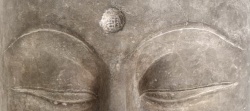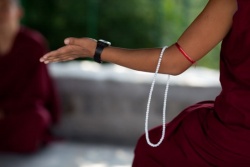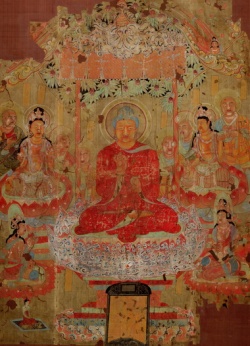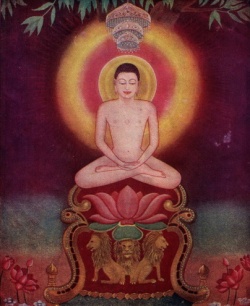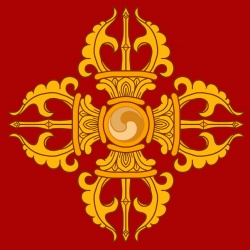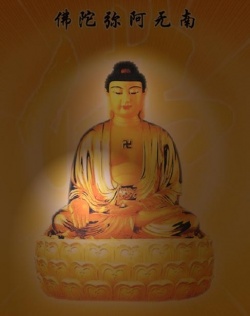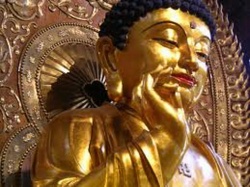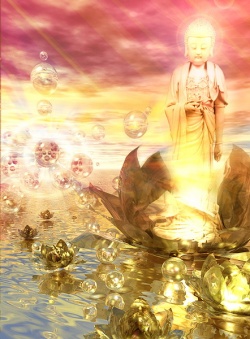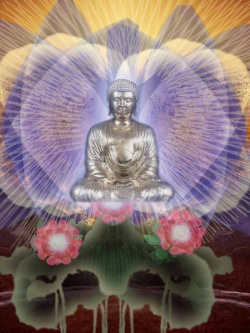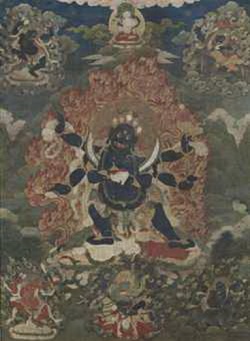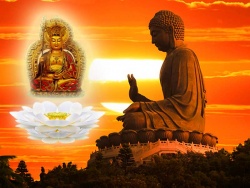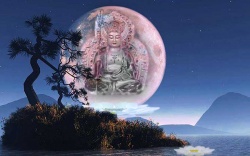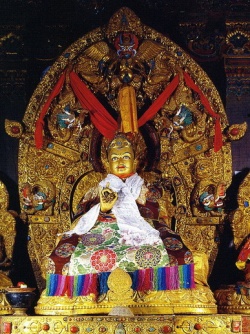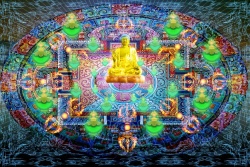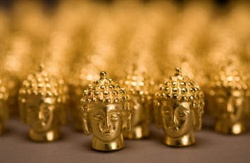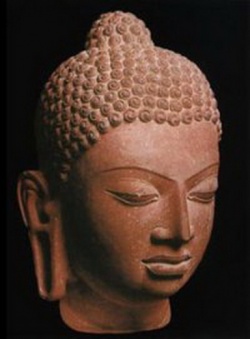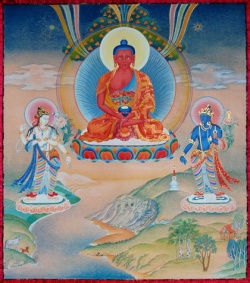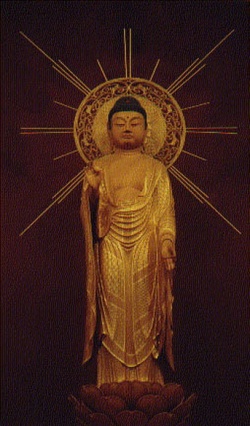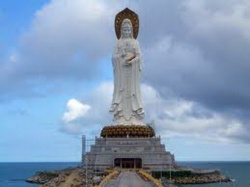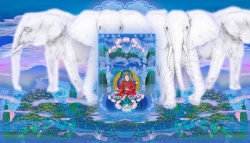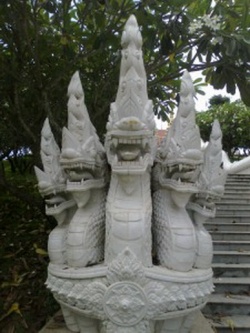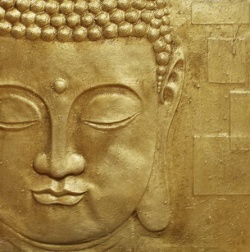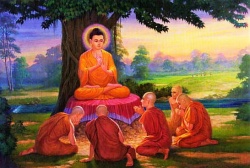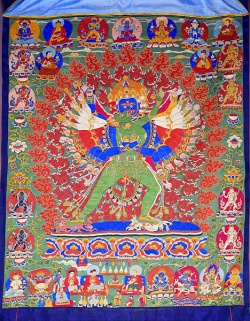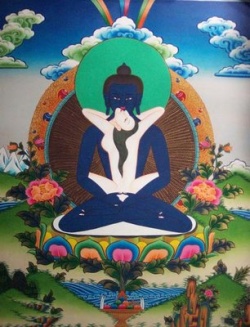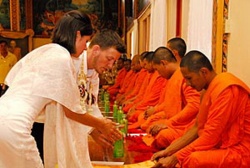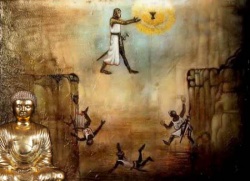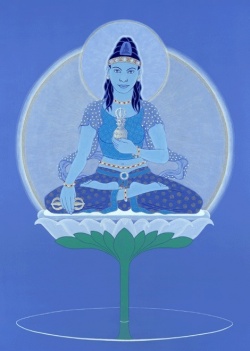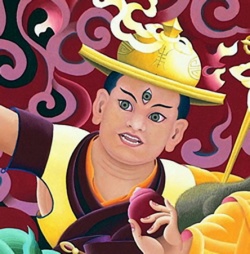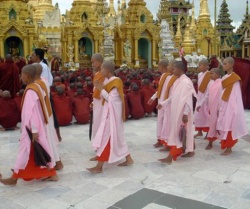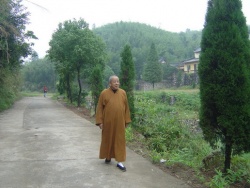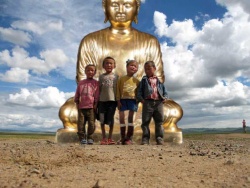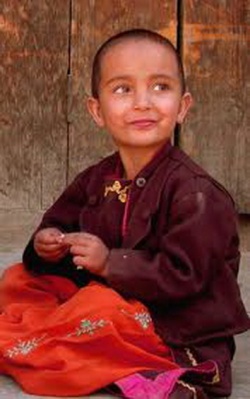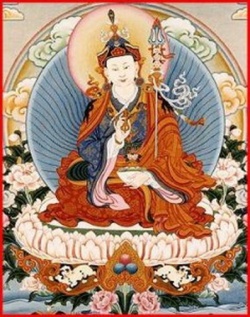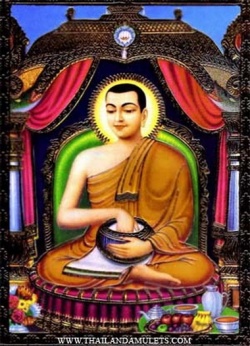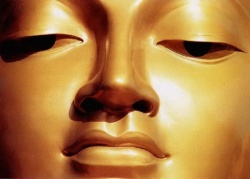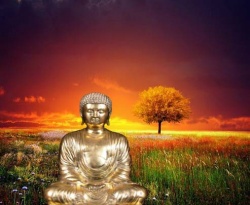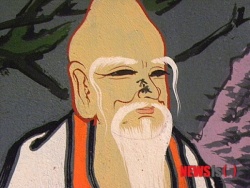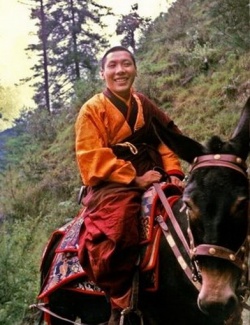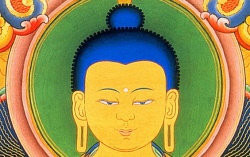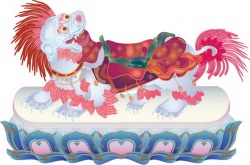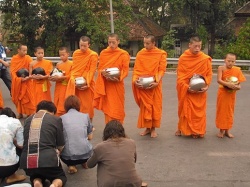The Hundred Syllable Vajrasattva Mantra.
The Hundred Syllable Vajrasattva Mantra.
Dharmacārī Jayarava
The Sanskrit version of the one hundred syllable Vajrasattva mantra in the Puja Book of the Friends of the Western Buddhist Order (the FWBO) follows the edited text produced by Dharmacārin and Sanskritist Sthiramati (aka Dr. Andrew Skilton) in his article:
The Vajrasattva Mantra: Notes on a Corrected Sanskrit Text. Sthiramati‟s original brief was to provide diacritical marks so that the Sanskrit words were spelled correctly.
However he went beyond the scope of merely providing proper diacritics to discuss problems with the structure and spelling of the mantra after consulting a number of printed books and manuscripts in a variety of scripts and languages.
Since the edited version produced by Sthiramati was adopted some 19 years ago, the problems with the older version used before that are less relevant to members of the Western Buddhist Order (WBO) except in one case which I discuss below.2
In this article I will offer a summary of the salient points of Sthiramati‟s lexical and grammatical analysis, along with my own glosses of the Sanskrit.
By this means, I hope to create an annotated translation that lays open the Sanskrit to anyone who is interested.
Sthiramati‟s interpretation differs in some important respects from the traditional Tibetan one, but does so in ways that help to make sense of the Sanskrit - for instance in several cases he suggests breaking a sandhi 3 one letter along in order to create a straightforward Sanskrit sentence that was otherwise obscured.
In the second part of the article I will address the problem of errors in transmission and how these might have come about in the case of this mantra. I will try to show that these errors are likely to have been introduced by a misreading of the text rather than a mishearing of the mantra.
I will explore the corrected mantra as a text. Sthiramati thought that his corrected Sanskrit version of the mantra did not affect its overall use and meaning, but in fact his changes do make a major difference in one case – the word which has been taken to mean „purify‟ is shown to not be a word.
I comment on the theme of purification, but look in particularly at the theme of our relationship (samaya) with the Dharmakāya, or Awakening.
I conclude with some remarks on the tension that the corrected Sanskrit produces with traditional approaches to mantra, high-lighting how it participates in the discussion about what constitutes an authoritative source in our new Buddhist movement (the FWBO).
vajrasattva samayamanupālaya vajrasattvatvenopatiṣṭha
dṛḍho me bhava sutoṣyo me bhava supoṣyo me bhava anurakto me bhava sarvasiddhiṃ me prayaccha sarvakarmasu ca me cittaṃ śreyaḥ kuru
ha ha ha ha hoḥ
bhagavan sarvatathāgatavajra mā me muñca
vajrībhava mahāsamayasattva
Annotated Translation
The first thing to notice is that the mantra is in Sanskrit and unlike most mantras contains a series of well-formed grammatical sentences.
The vajra was the weapon of Indra who, like the Greek Zeus, hurled thunderbolts at his enemies and was sometimes called Vajrapāṇi (thunderbolt wielder).
The word (as Pāli vajira) is not unknown in this sense in early Buddhist texts but in Tantra it is very prominent, and by this time also means „diamond‟, and metaphorically „reality‟.4
It‟s difficult to translate vajra in a way that conveys what is intended and for that reason it‟s often left untranslated. Sattva is an abstract noun from the present-participle sat „to be true or real‟ (from √as „to be‟ 5).
Sattva then is trueness/truth or realness/reality.
In use it is very close in meaning to our word „being‟, as in „a state of being‟, or „a being‟. Vajrasattva then is the „adamantine-being‟, „the thunderbolt reality‟, or the personification or embodiment of the true nature of experience.
In Buddhist mantras oṃ is there chiefly to signal that this is a mantra, or that the mantra starts here. Lama Govinda‟s eloquent speculations aside, oṃ does not seem to have any fixed esoteric associations in Buddhist exegesis.6
As with the speculations of the earlier Upaniṣads the symbolism varies with the context, often depending more on the number of syllables in the mantra rather than what the syllables are.
As Donald Lopez suggests: “… the Tibetan concern is generally with establishing a wide range of homologies between the six syllables of the mantra… and other sets of six in Buddhist doctrine.” 7
Taking the mantra one line at a time we find that when written in Devanāgarī it contains an ambiguity in the first line because of a sandhi phenomenon.
The line is conventionally written as -vajrasattvasamayamanupālaya- leaving us to find the word breaks with our knowledge of Sanskrit grammar!
Vajrasattva is most likely a vocative singular, meaning the mantra is addressed to Vajrasattva: „O Vajrasattva‟.
The phrase -samayamanupālaya- could be either -samaya manupālaya- or -samayam anupālaya-.
Both are commonly seen and the former is a traditional Tibetan approach, but -samayam anupālaya- is a natural Sanskrit sentence with -samayam- (in the accusative case) being the object of the verb -anupālaya-.
-Anu + √pāl means „preserve‟ and -anupālaya- is the second person singular imperative.
-Samayam- means „coming together‟ or „meeting‟ and is used in the sense of „coming to an agreement‟.
As a technical term in Tantric Buddhism it specifically refers to agreements the practitioner takes on when receiving abhiṣeka.
These agreements are sometimes referred to as a vow or pledge.9
To preserve an agreement is to honour it, so vajrasattva -samayam anupālaya- means: „O Vajrasattva honour the agreement‟, or „preserve the coming together‟ – the coming together of Buddha and disciple, or of guru and cela.
-Vajrasattvatvenopatiṣṭha- is again two words: -vajrasattvatvena upatiṣṭḥa- (a followed by u coalesces to o).
-Vajrasattvatvena is the instrumental singular of the abstract noun formed from the name Vajrasattva. -Vajrasattva-tva- could be rendered as „vajrasattva-ness‟, the quality of being a vajra-being.
The instrumental case usually indicates how the action of a verb is carried out, though Sthiramati points out that with abstract nouns the instrumental case is used to indicate in what capacity someone acts so that it means something like „as Vajrasattva‟.
The Verb here is -upatiṣṭha- a passive past-participle from -upa + √sthā- „stood near, was present, approached, supported, worshipped; revealed one‟s self or appeared‟. So the phrase means „manifest as Vajrasattva‟.
Things get simpler for a bit as we meet a series of phrases with the verb -bhava- which is the second person singular imperative of √bhū „to be‟.
They also contain the particle me which in this case is the abbreviated form of the 1st person pronoun in the dative „for me‟.
The form then is „be X for me‟.
First we have „be - dṛḍhaḥ’- „firm, steady, strong‟.
The -sandhi- rule is that an ending with aḥ changes to o when followed by -bha- : so -dṛḍhaḥ- -dṛḍho- . -Dṛḍho me- -bhava- means “be steadfast for me”.
-Sutoṣyaḥ- is a compound of the prefix su- meaning „well, good, complete‟ and -toṣya= from -√tuṣ- „satisfaction, contentment, pleasure, joy‟.
-Sutoṣyo me bhava- is therefore „be completely satisfied with me‟, or „be very pleased for me‟.
-Supoṣyaḥ- is again su- but combined with -poṣya- from √puṣ „to thrive, to prosper, nourish, foster‟.
-Sutoṣyo me bhava- is then „be fully nourishing for me‟. Sthiramati suggests “Deeply nourish me”.
- Anuraktaḥ- is -anu + rakta-. -Rakta- is a past-participle from -√rañj- and the dictionary gives „fond of, attached, pleased‟.10
In his seminar on the mantra Sangharakshita suggests „passionate‟ and this seems to fit better with √rañj which literally means „to glow red, or to redden‟.11
We can translate -anurakto me bhava- as „be passionate for me‟, or as Sthiramati suggests „love me passionately‟.
Now comes: -sarvasiddhiṃ me prayaccha-. -Prayaccha- is a verb from the root √iṣ „to desire, to wish‟ and means „to grant‟. (√iṣ forms a stem iccha; and pra + iccha > -prayaccha- which is also the second person singular imperative).
-Sarva- is a pronoun meaning „all, every, universal‟ and siddhi is a multivalent term which can mean „magical powers, perfection, success, attainment‟.
So -sarvasiddhiṃ me prayaccha- must mean „grant me every success‟ or „give me success in all things‟. Note that -sarvasiddhiṃ- is an accusative singular so it can‟t mean „all the attainments‟ (plural).
The next line is somewhat longer and more complex: -sarvakarmasu ca me cittaṃ śreyaḥ kuru-.
Ca is the connector „and‟, which indicates that we should take this phrase with the previous line. -Sarvakarmasu- is a locative plural.
The locative case is being used to indicate where in time and space the action takes place. -Sarva- we saw just above and karma means action - so this word means „in all actions‟.
Me here is a genitive „my‟. -Cittaṃ- is mind and is in the accusative case, so it is the object of the verb kuru which is the 2.p.s. imp of √kṛ „to do, to make‟.
Śreyah is from śrī which has a wide range of connotations: „light, lustre, radiance; prosperity, welfare, good fortune, success, auspiciousness; high rank, royalty‟. I think „lucid‟ would be a good choice in this case. It is the comparative so it means „more śrī’.
Putting all this together we find that -sarvakarmasu ca me cittaṃ śreyaḥ kuru hūṃ- means „and in all actions make my mind more lucid!‟
In Sthiramati’s version (and in most others) hūṃ is tagged on to this line, however I‟m inclined to separate it and leave it as a stand-alone statement; note that the three syllables -oṃ āḥ hūṃ- are used in the mantra, though not in that order.
In any case hūṃ is untranslatable. Kūkai sees it as representing all teaching, all practices and all attainments, so perhaps we could see this as Vajrasattva‟s contribution to the conversation?1
The string of syllables ha ha ha ha hoḥ won‟t detain us long since it is untranslatable and generally understood to be laughter. Sometimes it is said that each syllable represents one of the five Jina.
We could see this either as our response to the hūṃ of Vajrasattva; or as Vajrasattva‟s response to us.
Then we come to: -bhagavan sarvatathāgatavajra mā me muñca-.
Although these are sometimes broken up into separate lines, we put them together because there is one verb -muñca- (again in the second person singular imperative).
Bhagavan „Blessed One‟ is a vocative singular; this is how his disciples addressed the Buddha, although I think we are still addressing Vajrasattva here.
The phrase then is addressed to the Blessed One.
Sarvatathāgata on its own would also be a vocative singular, but this presents some difficulties since sarva is „all‟ but Tathāgata is singular.
Sthiramati suggests that this can be resolved by taking -sarvatathāgatavajra- as a single compound (allowing us to read tathāgata as a plural) meaning „O vajra of all the Tathāgatas‟.
Buddhists most often understand tathāgata to mean „thus-gone‟, taking -gata to be the past-participle of √gam „to go‟ – similarly sugata is translated as „well-gone‟.
This is not entirely wrong, but when -gata is used in compounds of this type, it loses its primary meaning in both Pāli and Sanskrit and means „being, being in‟.14
On this basis I agree with Richard Gombrich‟s suggestion that Tathāgata would make more sense if we read it as „being thus‟ or someone „in that state‟ – that is as the Buddha referring to his being awakened.15.
Mā is the negative particle „don‟t‟‟, and the verb, as I have said, is -muñca- from √muc „to abandon‟.
So -bhagavan sarvatathāgatavajra mā me muñca- means: „O Blessed One, vajra of all the Tathāgatas, do not abandon me!‟
In the final phrase -Vajrībhava mahāsamayasattva, vajrībhava- is an example of a factitive verbal compound. The noun vajra is compounded with the verb √bhū, the final a changes to ī, and the sense of
the word is causative, implying transformation: „become a vajra‟.
Again the conjugation is 2nd person singular imperative - so it‟s saying „you should become a vajra‟.
In his seminar Sangharakshita coins the word „vajric’ which Sthiramati does not like, but I can see what Sangharakshita might have meant: someone who becomes the vajra, in the sense of personifying it, might be described as vajric.
Note that there is another way of interpreting vajrībhava which is to take vajrī as the nominative singular of vajrin – a form of possessive.
-Vajrī bhava- , then (with a word break), might be taken to mean „be the vajra-bearer’.
This is how Sthiramati understood the phrase, and it fits the pattern of the other phrases. Either reading is possible.
-Mahāsamayasattva- is once again a vocative, and a compound of three words. I think here that mahā „great‟ qualifies -samayasattva- , which is a technical term in Tantric Buddhism – „agreement-being‟ - meaning the image of the deity generated in meditation which becomes the meeting place -(samaya)- for the practitioner and the Dharmakāya.
In a sense this is our contact with „reality‟ or „śūnyatā’ and we want it to go from being imagined to being genuine, so that we are transformed into a Buddha ourselves.
-Vajrībhava Mahāsamayasattva- then means „O great agreement-being become real!‟
The [[Hundredth syllable] is āḥ.
In Classical Sanskrit āḥ is an exclamation of either joy or indignation – similar to the way we might use the same sound in English. However in this context it is untranslatable.
Note that the mantra as a whole contains -oṃ āḥ and hūṃ - the symbols of body, speech and mind, and the corresponding aspects of the Dharmakāya.
Hūṃ and -phaṭ- are traditionally added under specific circumstances: hūṃ when the mantra is recited for the benefit of the deceased; and phaṭ when the mantra is recited to subdue demons.16 In the WBO/FWBO they are routinely included.
So my full translation goes:
O Vajrasattva honour the agreement! Manifest as Vajrasattva! Be steadfast for me!
Be very pleased for me! Be fully nourishing for me! Be passionate for me! Grant me all success and attainment and in all actions make my mind more lucid!
hūṃ ha ha ha ha hoḥ
O Blessed One, diamond of all those in that state, do not abandon me! Become real O great agreement-being.
Errors in Transmission
Tantric Buddhism is generally agreed to have emerged in the 7th century in India.
It continued to develop until Buddhism died out in India. Long after that, it was developed in the surrounding nations of Bhutan, Kashmir, Ladakh, Nepal and especially Tibet.
Having been conveyed to China and the Far East, this stream of transmission (and back-transmission) was cut off with the demise of the Silk Road and the collapse of the Tang dynasty in the late 9th century. This led to quite different lines of
development in Tibetan and Japanese Tantra.
Note that some scholars refer to the much earlier dhāraṇī tradition as being "proto-tantric", but this is like saying that flour is proto-cake.
Tantras were on the whole composed in Buddhist Hybrid Sanskrit (BHS), with the exception of the Kālacakra Tantra which was composed in Classical Sanskrit.
BHS is an inflected vernacular language which has been modified to be more like Sanskrit, a process known as Sanskritisation. This was a general trend and even Pāli has been Sanskritised to some extent.
My view is that mantras are also in BHS rather than Classical Sanskrit; for instance the -e ending on so many words being not, as many scholars assume, a feminine vocative, but a masculine nominative singular.
Writing during this time was somewhat different to the present day.
The script in widespread use in Northern India at the time of the emergence of Tantric texts is known by several different names, but it is now generally called Siddhaṃ (perfected) or Siddhamātṛka (matrix of perfection).
A version of this script, adapted for writing with a Chinese calligraphy brush, is preserved in the Chinese Tripiṭaka for writing mantras - even when they are also transliterated into Hanzi.
The Tibetan script dbu-can (pronounced „uchen‟) was designed on the model of an early Siddhaṃ script.
In the latter part of the Tantric period (ca. 12th century) the script which is now often referred to simply as Sanskrit, but which is more correctly called Devanāgarī (literally: „City of the Gods‟) began to supplant Siddhaṃ. 18
A feature of texts of this period is that syllables were not grouped into words, but written one at a time with little or no punctuation. In order to read a text like this one had to have a very good knowledge of Sanskrit word endings.
Here is the Vajrasattva mantra written as it might have been in, say, the 10th century using the Devanāgarī script:
ओं व ज्र स त्त्व स म य म नु पा ल य व ज्र स त्त्व त्वे नो प ति ष्ठ दृ ढो मे भ व सु िो ष्यो मे भ व सु पो ष्यो मे भ वा नु र क्तो मे भ व स वव तस द्धिं मे प्र य च्छ स वव क मव सु च मे तच त्तं श्रे य कु रु हं ह ह ह ह होोः भ ग व न्स वव ि था ग ि व ज्र मा मे तमु ञ्च व ज्री भ व म हा स म य स त्त्व आोः
Some of the mistakes that crept into the Vajrasattva mantra over time, or perhaps even all at one time, seem to me to be the result of misreading rather than mishearing. Note that Tibetan writing is open to the same kinds of difficulties in reading as Sanskrit.
Take this segment for instance:
व ज्र स त्त्व स म य म नु पा ल य = va jra sa ttva sa ma ya ma nu pā la ya
As I noted in my translation there are several ways to clump the syllables into words.
The first four naturally form the name of Vajrasattva.
This leaves -sa ma ya ma nu pā la ya-. If we are versed in Tantra but not so much in Sanskrit we might be attracted to the word samaya.
Because this is a mantra we may not be expecting formal grammar, so we might take that as a unit.
This leaves us with -manupālaya-.
This is not well formed Sanskrit, but it has familiar parts.
-Manupālaya- is interpreted as meaning „a defender -(pāla)- of man (manu)‟, but -pālaya- is not a proper word - at best it could be taken to be a (commonly encountered) faux dative,20 but even this is not much help.
-Manu- can mean man (singular) but in the sense of „the first man‟ or progenitor (like Adam), though more often it means mind (cf. mati).
As a neophyte Sanskritist I have fallen into a similar trap many times. The problem is that when a word ends in -m and the next word begins with a- the two are combined into a single syllable ma for the purposes of writing.
So sa ma ya ma nu pā la ya is actually -samayam anupālaya- 'uphold the agreement'.
In accurately pronounced spoken Sanskrit this error would be less likely to occur.
By way of contrast an example of an error that seems to be the result of a mishearing is the word -prayaccha-. Sthiramati found only this spelling in his research.
All of Sthiramati‟s Tibetan texts and several that I‟ve checked spell -prayaccha- in one of two ways (transliterating the Tibetan script): -prayatstsha- or -prayaccha-.
Tibetan often transcribes -ca- as -tsa- and -cha- as -tsha-, for instance they write -a ra pa tsa na-, and the two pairs are quite close in pronunciation. However in the version of the mantra in Sangharakshita‟s seminar we find the spelling preycha, with apparently the same meaning.
It is easy for the first two syllables – praya – to start to sound like „prey‟ (it is what we might expect from an English speaker).
This is much less likely to be a misreading since it mostly seems to be transcribed correctly.
A more crucial error in reading occurred further along. स वव क मव सु च मे तच त्तं श्रे य कु रु = sa rva ka rma su ca me ci ttaṃ śre ya ku ru
This phrase is at the heart of the traditional use to which the mantra is put - the purification of karma.
Let me review what I think may have been the procedure for producing this reading based on my own experience of reading an unfamiliar Sanskrit text.
Keep in mind that we know this is a mantra and mantras seldom follow grammatical rules so in translating, or even transliterating the mantra we do not expect to see words with proper inflections.
Several familiar words stand out: -sarva- (all), karma (action), -cittaṃ- (mind) -kuru- (make).
This leaves some bits and pieces. Some thought makes clear that śreya is related to the word -śrī-, and that me is 'me' or 'mine'.
We're left trying to explain -su ca-.
-Suca- (often spelt -sucha- to avoid the confusion on how to pronounce c in English) isn't a word, but it is similar to words related to √śuc 'to gleam', figuratively 'to clean or purify'.
The basic form is -śocati- (he/she/it purifies), past-participle -śukta-, infinitive -śuktum-, second person singular imperative -śoca-.
We can see that there is a similarity, and we might consider that this is close enough for a mantra. So -sarva karma suca me- by this process came to mean 'purify all my karma‟, and this came to be the most important phrase in the mantra.
But the shift from the palatal sibilant „ś‟ to the dental „s‟ is a much greater one than the Romanisation suggests – they are not interchangeable. Also Tibetans usually get the vowels right – it is certain consonants that cause pronunciation problems.
Well-formed Classical Sanskrit sentences do not just form at random.
The chances of taking any series of syllables, gathering them into clumps, and finding sentences are exceedingly small.
Garble is far more likely, and that is commonly encountered in mantras. This means that the best explanation is that the formal Sanskrit we find in the mantra when we fiddle with word-breaks is the original text.
Given that the mantra was composed in Classical Sanskrit it suggests that it may well be from the same milieu that created the Kālacakra Tantra.
A corollary of this is that the mantra only gained its association with the purification of karma after it had been garbled and that this was not the original intention of the mantra.
Not only that, but the way the message is garbled suggests to me that the mantra was passed on without explanation at some point, and then later on an exegesis was composed largely based on the mis-read rather than a mis-heard Sanskrit text.
Indeed I wonder whether the text was passed on in written form because an oral tradition would have preserved the Sanskrit rhythms of speech that would have made this kind of mistake quite unlikely.
I would imagine that this did not happen on Indian soil.
This finding of the underlying Sanskrit text, and my conjecture about it, creates a significant tension with the received tradition which revolves around purification of karma.
Next I will explore some implications of this tension, and look at the theme that emerges into the foreground when the spurious reference to purity is removed: samaya.
Themes of the Vajrasattva Mantra
Having dealt with some of the issues of the linguistics of the mantra, I want now to look at the mantra as a text.
While in the Tibetanized version the main theme is taken to be purification of karma, in the corrected Sanskrit one of the other themes emerges into the foreground: -samaya-.
-Samaya- is our relationship (or agreement or meeting place) with Vajrasattva, the embodiment or personification of the Dharmakāya.
I want to explore the nature of this relationship in various terms which will demonstrate some continuity.
Firstly let me say something about the purification of karma.
The Buddha took the theme of ritual purity, and ethicised it – purity according to early Buddhism consists in ethical purity; it is acting from „pure‟ motives which are defined in terms of the absence of craving, aversion, and confusion.
I have showed in an article on Confession that from the point of view of early Buddhism willed actions (karma) inevitably produce results (vipaka).21 The fruits of actions cannot be eliminated or 'purified'.
I declare monks, that actions willed performed and accumulated will not become extinct as along as their results have not been experienced, be it in this life , in the next life, or in subsequent future lives.
And as long as these results of actions willed, performed and accumulated have not been experienced, there will be no making an end to suffering dukkhassantakiriyaṃ.22
This concept is graphically illustrated in the Aṅgulimāla Sutta (MN 86). Not long after Aṅgulimāla had become an Arahant some villages pelted him with missiles breaking his begging bowl, tearing his robes and causing a bloody cut on his head.
The Buddha‟s response was to tell him “you must endure it Brahmin” (adhivāsehi tvaṃ, brāhmaṇa).
“You are now experiencing the fruits of actions (kammassa vipākena) that might otherwise have resulted in many years of suffering in hell.”
However several other suttas, but in particular the Lonaphala Sutta (AN 3.99) appear to allow for the mitigation of the effects of actions.
In a footnote to my confession article I also noted that in later versions of the Samaññaphala Sutta this doctrine began to change.24
Whereas in the Pāli the story of Ajātasattu confessing to the Buddha that he has killed his father is only the frame for a larger doctrinal exposition, in the surviving Sanskrit fragment and three Chinese translations Ajātasattu's confession is the main focus.
In the Pāli version there is no way to prevent the devastating effects of his actions,25 and the commentary on the story tells us that at death he goes straight to the Hell of Copper Kettles.
The later versions all make his meeting with the Buddha trans-formative and state that, to varying degrees, Ajātasattu is released from the effects of his 'unforgivable' actions.
One tells us that he is free from the āsavas, that is he was Awakened, after meeting the Buddha.26
Indeed it seems that this doctrinal reversal became an important theme in Mahāyāna Buddhism and is epitomized by the Tantric practice of purifying karma through the recitation of this mantra.
Samaya : our relationship with Enlightenment
The theme of samaya is distinctively Tantric, though it has resonances with earlier traditions.
Samaya, as I have explained, means 'agreement, meeting, meeting place' and could also be translated as relationship.
The idea is brought out quite poetically in Kūkai's expositions on kaji (Sanskrit adhiṣṭhāna).27 The idea is that it is not just the practitioner reaching out towards a remote and
disinterested goal, but that the Dharmakāya is doing its bit to reveal itself – hence we call upon Vajrasattva: [[vajrasattvatvenopatiṣṭha] „manifest as Vajrasattva!‟ Lest we feel this idea is too theistic or anthropomorphic I want to unpack it a bit.
In the Heart Sūtra it says that all dharmas are marked by emptiness (sarvadharmāḥ śūnyatā-lakṣanā).
This is entirely in keeping with the earliest (pre-abhidharma) notions on the nature of dharmas.
Dharmas are the units of experience, both the information from the senses, and the mental aspects of consciousness such as memory, associative and inductive thinking.
Experiences, the focus of discussions of dependent arising, have no ontological status - they are not solid existent 'things', nor are they non-existent.
The terms existent and non-existent do not apply to experience.
All that we know and are conscious of results from contact between objects and sense organs giving rise to dharmas - in this sense the word means 'foundation'.28 Dharmas in themselves are neither pure nor impure.
However we do not treat dharmas or experience this way: we take them far more seriously than this, as existent and important. We spin stories (prapañca) about our experience which we believe and invest with value.
In this way we make our fundamental errors which lead to suffering.
Purity (vimala) and impurity (mala) are concepts which we project onto experience – hence the Heart Sūtra says: amala avimala.
Now the agreement, the samaya, with the Dharmakāya says something like this: if you seek, you will find. In other words the true nature of experience, the śūnya nature of dharmas, is always available to be discerned; it can't be permanently hidden from us.
If we go about it in the right way, we will see through (vipaśyanā) our delusions. This is an important aspect of Buddhist faith.
The guarantees that it is true come in many forms amongst which „Buddha Nature‟ stands out as a good example. Buddha Nature, like this samaya, is designed to set your mind at ease about the possibility of your liberation - particularly in the light of seemingly endless reservoirs of craving, aversion and confusion.
Likewise the samaya uses the model of an agreement between two parties to assure us that we can realise the Dharmakāya and be liberated.
Just as Sangharakshita has pointed out in his Heart Sūtra commentary, here the form is as important as the content.29 The mantra, like the Heart Sūtra, can be seen as a dialogue.
On the one hand the chanter is reminding Vajrasattva, as the personification of the nature of experience, of his side of the samaya relationship: we need the possibility of gaining insight into the true nature of experience to remain open to us, so that we can be liberated.
On the other hand the seed-syllables are Vajrasattva's response to us. Vajrasattva reminds us that it is we who project onto our experience, not him, that he, i.e. the nature of experience, is always available to us, and that nothing can ever change that.
Śūnyatā, pratītyasamutpāda, Buddha Nature, and so on, are all ways of pointing to the nature of experience - saying the same thing in different ways.
Vajrasattva replies in non-linear, non-rational fashion because typically it is very difficult to think straight about this subject.
Typically we are completely caught up in, or intoxicated with (pramāda) our stories, and we cannot really think outside that narrow context.
In Tantric terms oṃ āḥ and hūṃ represent not just our mundane body, speech and mind, but also the Three Mysteries (trighuya).
These are the 'body', 'speech', and 'mind' of the Dharmakāya which are communicated through Vajrasattva‟s use of mudrā, mantra, and maṇḍala. These three also become the technology by which we align our body, speech and mind with the Dharmakāya and become enlightened.
A note on Pronunciation
The early Tantric tradition took on the Vedic concern for accurate pronunciation and initially transmitted this beyond the boundaries of India.
For instance Kūkai wrote in the 9th century that mantras should be recited “…in secret, pronouncing them distinctly without making the slightest error”.30
However the phonetic palettes outside of India made Sanskrit pronunciation difficult and at some point – although I‟ve yet to see a scholarly discussion of this – pragmatic allowances were made.
Mantra pronunciation is still standardized in Tibet and Japan, but in local forms. Both countries also retain ways of preserving the original Sanskrit of mantras in writing.
Pronunciation is still an issue; in a recent personal communication to me, Sangharakshita expressed his wish that the mantra be pronounced in the FWBO as it was given to him by Dudjom Rinpoche – that is to say the version of the mantra that appears to have been corrupted.
This wish is in keeping with traditional narratives on the transmission of mantras, though in this case there is some tension because we can be reasonably certain that at some point the mantra has been corrupted.
Insisting on transmission from guru to disciple works well in an environment where everyone has the same accent.
In an international movement accents become an issue – if we all did a mantra as taught by our preceptor, with no external standard, then we would start to diverge very quickly as national phonetics played their part – for instance, svāhā is soha in Tibet and sowa ka in Japan. Without an external standard, changes such as these multiply.
The Sanskrit language itself can provide such a standard, though as I have said, my opinion is that most mantras were not composed in Classical, but in Buddhist Hybrid Sanskrit.
The question then becomes: how far do we take this – is it permissible to do what we have done and reconstruct the Sanskrit? What is the guiding principle here?
Conclusions
In the first section of this article I have re-presented the essentials of Sthiramati‟s analysis of the Vajrasattva mantra as it appears in the FWBO Puja book, explaining the grammatical and lexical forms along with my own glosses of the meanings.
Given that the mantra is an important part of the FWBO liturgy it seems appropriate that this kind of information be available to those who might want it but lack the language skills necessary to work it out from scratch – and reading Sanskrit is a rare skill in the FWBO.
A fresh presentation seemed to be required because many of the issues being addressed by Sthiramati ceased to be issues with the publication of the new edition of the Puja Book in 1990, and because the 1990 article is now very difficult to locate.
Absolute certainty is never possible, but it seems very likely that the mantra that we inherited was corrupted and that in his reconstructed version Sthī. ramati has restored the syntax and spelling of the mantra to its uncorrupted form. Certainly this seems to be the view of other Sanskritists that I have spoken to.
However the issue of transmission errors is likely to remain a live one since there seem to be two schools of thought: the first, assented to by what I believe is a small minority, is that the corrected Sanskrit is the version of the mantra that we should chant because it represents something more original.
The second school of thought, which represents the majority, holds that one should only ever chant a mantra as it was transmitted in an initiation because this is more authentic.32
One problem is that most of us who practise within the context of the FWBO pick up mantras informally in pujas without any formal initiation or instruction.
Moreover, when Order members come to receive a mantra at ordination, it is likely that the preceptor passing on the mantra would not have received it directly from their own preceptor, but rather through a process which works by a kind of osmosis.
The issue then is one of authority and what, or who, constitutes a source of authority in the case of mantras. For scholars with the language skills and access to libraries the text is a primary source of authority.
For non-scholars the teacher or preceptor and tradition are primary. This is understandable,
but it raises the issue of the role of scholarship and higher criticism in the FWBO. Although we are nominally open to higher criticism, it seems to me that convention usually trumps scholarship.
The fact is that we have two distinct versions of the Hundred Syllable mantra in the FWBO – one which Sangharakshita prefers, has lectured on, and transmitted to many disciples, and one which for almost two decades has graced our Puja Book.
And since we always include the hūṃ and phaṭ we actually chant 102 syllables in both cases.
The lack of certainty about the provenance of our mantra seems to produce a situation which is at least similar to the uncertainties surrounding bhikkhu ordination, as has been explained by Sangharakshita.
All this goes to show that technically valid ordination is virtually impossible of attainment and that if one did, miraculously, obtain it, one could not know that one had done so.33
Another related issue is how we use traditions to legitimise our practice.
If, for instance, we refer to Tantric Protocol to justify the retention of a corrupt pronunciation because it came from an authoritative source (in this case Dudjom Rinpoche), then we need to be aware that this authoritative source would most likely have disapproved of our unorthodox treatment of Tantric tradition.
One can hardly imagine a Tantric guru approving of our doing away with abhiṣeka for instance, or with mudrā, or with many other vital aspects of the Tantric approach.
Having re-contextualised those aspects that we have adopted, it becomes less plausible to claim support from tradition, and yet this is precisely what we do.
This being so, we may need to reconsider how we approach the subject of authority and the legitimation of our practices especially in the area of mantra.
I would like to suggest that certain Mahāyāna Sūtras provide a different approach which may be relevant. I‟m thinking here in particular of the Sukhāvativyūha Sūtras, the Saddharmapuṇḍarīka and the Kāraṇḍavyūha Sūtras.
All of these frame chanting in terms of nāmānusmṛṭi or buddhānusmṛṭi: recollections of the name of the Buddha and the Buddha respectively.
In this approach the faith of the devotee is paramount and as long as the intention is to invoke the Buddha, the details of how that is done are less strictly spelt out by the sūtras I have mentioned. It would allow us more scope for recontextualisation while maintaining the link to tradition.
Perhaps others will also appreciate the irony that the concern for purity which surrounds this mantra conflicts with a concern for the purity of the mantra itself. In this article, I have raised a question about the nature of purity, and how it can be achieved.
I have highlighted the fact that the nature of purity and nature of impurity result from projection; each is something that we add to experience and is not intrinsic to it. Likewise we have conferred on the mantra ways of chanting it and understanding it that are not intrinsic to it.
In early lectures in which he talks about this mantra, Sangharakshita uses the language of original purity and even of immanence, but over the years, and particularly recently, he has been at pains to point out the risks of using this kind of terminology. This suggests that we may need to revisit our narratives relating to the mantra.
References
Attwood, Jayarava Michael (2008) „Did King Ajātasattu Confess to the Buddha, and did the Buddha Forgive Him?‟, Journal of Buddhist Ethics, vol. 15.
The FWBO Puja Book, 5th ed. (1990) Windhorse Publications; also 7th ed. retitled: Puja: The FWBO Book of Buddhist Devotional Texts, 2008.
Chandra, Lokesh and Snellgrove, David L. (1981) Sarvatathāgatatattva Saṅgraha, New Delhi: Sharada Rani.
Gair, J.W. and Karunatillake, W.S. (1998) A New Course in Reading Pāli. Motilal Banarsidass.
Gombrich, R. (2009) What the Buddha Thought, London: Equinox.
Govinda Lama Anagarika (1959) Foundations of Tibetan Mysticism. Rider.
Gulik, R. H. van (1956) Siddham: An Essay on the History of Sanskrit Studies in China and Japan, Nagpur: International Academy of Indian Culture. (Also available as a reprint from Aditya Prakashan, Delhi).
Hakeda, Yoshito (1972) Kūkai: Major Works, Columbia University Press. Jayarava (2006) „Buddhism as a path of Gracefulness‟ in Jayarava’s Raves [18-7-2006]. http://jayarava.blogspot.com/2006/07/buddhism-as-path-of-gracefulness.html Jayarava (2009a) „Words in Mantras that end in –e‟ in Jayarava’s Raves [6-3-2009]. http://jayarava.blogspot.com/2009/03/words-in-mantras-that-end-in-e.html Jayarava (2009b) „Dharma: Early History‟ in Jayarava’s Raves [9-10-2009]. http://jayarava.blogspot.com/2009/10/dharma-early-history.html, Jayarava (2009c) „Dharma: Buddhist Terminology‟ in Jayarava’s Raves [19-6-2009]. http://jayarava.blogspot.com/2009/09/dharma-buddhist-terminology.html Jayaraa (2009d) „Dharma as Mental Event‟ in Jayarava’s Raves [23-10-2009]. http://jayarava.blogspot.com/2009/10/dharma-as-mental-event.html
Lopez, Donald S. (1998) Prisoners of Shangri-La : Tibetan Buddhism and the West, University of Chicago Press. Macdonell, A.A. (1926) A Sanskrit Grammar for Students (3rd ed.), D.K. Printworld Ltd, 2008. MacQueen, G. (1988) A Study of the Śrāmaṇyaphala-sūtra, Wiesbaden: Otto Harrassowitz. Monier-Williams, M. (1899) A Sanskrit-English Dictionary. [New Edition greatly Enlarged and improved by Leumann, E. and Cappeller, C.] Reprinted by Delhi: Asian Educational Services, 2008.
Nyanatiloka and Bodhi (1999). Numerical Discourses of the Buddha: an Anthology of Sutta from the Aṅguttara Nikāya, Walnut Creek, Maryland: Altamira Press.
Salomon, Richard (1998), Indian Epigraphy: A Guide to the Study of Inscriptions in Sanskrit, Prakrit, and the Other Indo-Aryan Languages, Oxford University Press.
Sangharakshita The Vajrasattva Mantra Seminar, Free Buddhist Audio. http://www.freebuddhistaudio.com/texts/read?num=SEM152&&at=text
Sangharakshita (1968) „Track 7, „The Meditation and Mantra Recitation of Vajrasattva: purification‟, in The Four Foundation Yogas of the Tibetan Buddhist Tantra. http://www.freebuddhistaudio.com/talks/details?num=60
Sangharakshita (1993) Wisdom Beyond words: Sense and Non-sense in the Buddhist Prajnaparamita Tradition. Birmingham: Windhorse Publications. Sangharakshita (1994) Was the Buddha a Bhikkhu? A Rejoinder to a Reply to Forty-Three Years Ago. Glasgow: Windhorse Publications.
Snellgrove, David (2002) Indo-Tibetan Buddhism: Indian Buddhists and their Tibetan Successors, Boston: Shambala.
Sthiramati [aka Skilton, Andrew] (1990) „The Vajrasattva Mantra: notes on a corrected Sanskrit text‟, Order Journal, vol.3, Nov.
1 My thanks to Dharmacārīs Aśvajit and Sāgaramati for comments on a draft of this paper, and to Jñānaketu for help getting it to print. Any remaining errors or infelicities are of course down to me.
2 The text of the old version can be found in various pre-1990 editions of the Puja Book (though according to Sthīramati there is some variation), and in Sangharakshita‟s unpublished unedited seminar The Vajrasattva Mantra (see bibliography). I refer to this version as Tibetanised. 3 Sandhi literally means 'junction', but here it is a technical term for how the spelling of words change because of their proximity to each other. For instance in English we change from 'a bear', to 'an apple' (a > an before a vowel sound).
4 By the time Tantric Buddhism adopted this symbol – circa 7th century CE – Indra was no longer prominent in India religion. He does occur in Buddhist texts however where he is known as Śakra (P. Sakka) – for instance he makes regular appearances in the Pāli Jātaka tales and is a prominent figure in the Aṣṭasāhasrikā Prajñāpāramitā Sūtra (The Perfection of Wisdom in 8000 Lines).
5 √ indicates a verbal root. Sanskrit grammarians analysed verbs into roots, stems, and suffixes indicating conjugation. The monosyllabic root or dhātu is notional but carries the primary meaning of the word, which can be modified with prefixes. Dictionaries, particularly the popular Monier-Williams Sanskrit-English Dictionary, are often organised according to roots.
6 Foundations of Tibetan Mysticism is a popular book, however in his explanations of mantra generally and of oṃ in particular Lama Govinda cites only Hindu texts - which I have always found puzzling. He is viewed with some suspicion by some: see for instance comments in Lopez (1998). 7 See Lopez (1998). 150.
8 In Tibetan Sadhanas one frequently sees a version of this mantra where the word vajra is substituted by padma to form the Padmasattva mantra; in a version to Heruka Vajrasattva where we find Vajra Heruka instead of Vajrasattva.
9 Snellgrove explains that the word means „a sacrament‟ when used in a ritual context, but regularly translates it as „pledge‟ (2002), p.165. C.f. the word saṃvara a „bond‟ or „restraint‟ which is used in the sense of taking on rules of behaviour.
10 Note the root is not √rakṣ „to protect‟ which would give rakṣita „protected‟ as a past-participle, though this interpretation is encountered in some Tibetan exegesis.
11 The same root gives us the word rāga – emotion, feeling, passion. 12 Most Tibetan traditions seem to take this as sarva karma suca me but this is much more difficult to resolve as sensible Sanskrit. Tradition takes it to mean „purify all my karma‟ seemingly taking suca to be related to √śuc although this cannot be the case. However this tradition is very important as it relates to the purifying function of the mantra – and purification is not otherwise mentioned even indirectly. I discuss this below.
13 For Kūkai‟s exegesis of hūṃ see „Ungi gi‟ in Hakeda (1972), p.246ff. 14 See for instance: Macdonell (1926) p.171, n.4; and Gair and Karunatillake (1998), p.25.
15 C.f. Gombrich (2009) p.151. Gombrich points out that the traditional Buddhist attempts to etymologise the term are “fanciful”. I would also argue that though “thus-gone” has become familiar, it is poor English, and in fact quite meaningless. 16 Incidentally phaṭ is pronounced „p-hut‟ not „fat‟. Sanskrit doesn‟t have an „f‟ sound – ph is „p‟ followed by a puff of air similar to the sounds in the word „tophat‟.
17 I explore this in my blog Jayarava (2009a)
18 The history of Indian Writing is comprehensively surveyed in Salomon (1998). For the adaption of the Siddhaṃ script in Asia see: Gulik (1956). 19 I have modelled this on the 10th century Siddhaṃ script manuscript of the Sarvatathāgata-tattvasaṃgraha published as a facsimile edition by Chandra and Snellgrove (1981), though the mantra in that text is slightly different again.
20 In mantras we often find a noun with the suffix -ya or -ye and I interpret this as a naïve effort to form a dative on the model of true datives (e.g. deva > devāya, or muni > munaye, but note the vowel changes due to sandhi). I‟ve coined the term “faux dative” to describe this phenomenon. The use of datives followed by svāhā to form mantras dates back to the Yajurveda where they are common: e.g. agnaye svāhā.
21 Attwood (2009).
22 Nyanaponika and Bodhi. (1999). p. 269. [PTS A v.292]
23 PTS M ii.104. My translations.
24 Several later versions of the Samaññaphala Sutta are translated and studied in MacQueen (1988).
25 Patricide is said to be atekiccha: “incurable” or “unpardonable”. (see for example A iii.146).
26 MacQueen (1988). p.69.
27 I wrote about this as „grace‟ in Jayarava (2006). 28 I explore the meaning of the word Dharma in three short (and probably overly ambitious) essays Jayarava:2009b, 2009c, 2009d. 29 Sangharakshita (1993), especially p.25f. 30 Kūkai. Benkenmitsu nikyō ron in Hakeda (1972), p.220.
31 A further avenue of research has opened up recently as Maitiu O'Ceileachair and I have identified the earliest textual reference to the Vajrasattva Mantra in the Chinese Tripiṭaka, in „A Summary of Recitations‟ (T.866). The summary is a selection of mantras from the Sarvatathāgata-tattvasaṃgraha translated into Chinese in 723 CE by Vajrabodhi based on a text obtained in India around 700 CE (which incidentally sets the upper limit of its composition). We are comparing the various Chinese and Tibetan canonical versions with the extant Sanskrit manuscripts which should reveal more about the nature of the transmission process and the form of the mantra at this earliest stage of its history.
32 I don‟t mean to insist on the terms „original‟ and „authentic‟ or to boil the dialogue down to a simple dichotomy. In many ways the concerns of each camp overlap. 33 Sangharakshita (1994) p.15 [my emphasis]. </poem>


